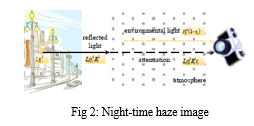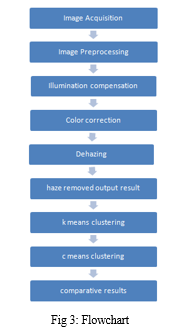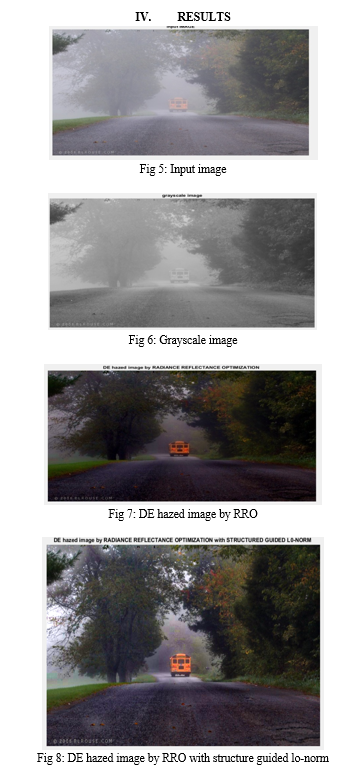Ijraset Journal For Research in Applied Science and Engineering Technology
- Home / Ijraset
- On This Page
- Abstract
- Introduction
- Conclusion
- References
- Copyright
Single Image Haze Removal with Radiance Reflectance Minimization Using Illuminated Optimization and K-Means Clustering
Authors: P Manesh Reddy, H Sai Sravya, Rithesh Kunchakuri, G Preetham Reddy, C Dhanush Chalicheemala
DOI Link: https://doi.org/10.22214/ijraset.2023.54865
Certificate: View Certificate
Abstract
Haze removal is one of the important factors considered to avoid accident on roads during travelling. Most of the accident occurred in the snow and cloudy regions are due to the haze formation in road while driving. The view occurred on nighttime is differ from the view on daytime. During nighttime improper illumination will occur due to artificial light source with color distortion. In this paper the new method is developed to overcome de haze proper due to improper illumination and scattering of the light. Three step process is implemented in this i) Initially the radiance reflection optimization is performed ii) Once it is applied then to remove the haze the radiance reflection optimization with structured LO-NORM is performed iii) The haze in an image is removed from an image by applying the dark channel method and the illumination level will be estimated. The PSNR value of an image is calculated to check the quality of an image. Then the clustering for a de hazed image is performing using k-mean and fuzzy c-mean (FCM). The result show that the prospective process is better than current one and illumination balance is done effectively, and the image will be haze free.
Introduction
I. INTRODUCTION
Cloudiness may change the hues and lessen the differentiation of the caught pictures. The degradation is generally brought about by the light scattering and light narrowing noticeable all around. It is critical to expel the cloudiness from the debased pictures for various applications. Numerous de hazing strategies have been proposed to manage daytime fog pictures. Different picture-based techniques require at least two pictures of a similar scene either under various atmosphere condition [1]. Haze formation is differentiated has daytime and nighttime. Day time haze problems will cause accident due to snow or fog formation while driving but the nighttime haze is an important factor due to visible light source with varying color and infrequent segmentation [2].
As of late, various daytime dimness evacuation models have been proposed to address the dim picture availability upgrade. The way into their prosperity generally depends on the right estimation of different picture priors, and climatic light [2].
We could possibly know, there are little written works about evening fog expulsion in the previous decades. Histogram leveling (Heq) is one well known strategy to upgrade large differentiation of a picture the complexities of certain districts like dividers, trees and structures have been upgraded. In any case, because of the uneven light at various focuses and the subsequent wide hole of intensities between them, Heq intensified the powers of locales [3]. In the splendid territories, for example, the sky, the evaluated transmittance of dull channel earlier is low, so the handled picture shows up shading twisting. Moreover, the power of the fog free picture through dim channel earlier is dim and the picture's complexity is low. Improved calculation proposed focused on the two imperfections [5].
II. LITERATURE REVIEW
Haze may change the colors and diminish the difference of the caught images. The degradation is for the most part brought about by the light dissipating and light constriction in the environment . It is essential to expel the haze from the corrupted pictures for various applications. Numerous de-right of passage strategies have been proposed to manage daytime murkiness pictures. Numerous picture based strategies require at least two pictures of a similar scene either under at least two pictures of a similar scene either under various climatic conditions. High resolution remote sensing (RS) taken by earth observation satellites have been generally utilized in meteorology, forestry, hydrology and military since they contain rich spatial and geographical data.
However, RS pictures captured in hazy climate are plagued by low perceivability because suspended in the atmosphere,bringing in contrast reduction and color distortion. The interference caused by haze directly affects the accuracy of RS image highlight extraction ,which can prompt mistakes in vision frameworks .In this way , haze removal for RS images are crucial. Now a day’s low visibility condition is a frequent occurrence. Due to fog and haze, visibility is impaired. Poor visibility causes flight delay, diversion, cancellation as well as automobile accidents. Driving at night in case of fog forms a challenging condition which may lead to a fatal accident. We have seen a drastic change in the environmental condition also pollution has aggravated the problem and proving to be fatal. This issue prevails on a larger scale in the industrial region but with the escalating development and industrialization, it won’t take long to spread across the country. Thus, the problem is to deal with such situations in which human performance is limited by low visibility.
A. Radiance Reflectance Estimation
Outdoor images are subject to degradation with respect to contrast and color due to the environmental particles disperse approaching light to a camera .Existing haze models that utilize model based dehazing methods couldn’t avoid the dehazing artifacts. These artifacts incorporates color distortion and over enhancement around object limits due to incorrect transmission estimation from depth error in skyline and also incorrect haze data particularly in bright objects. To beat this issue, we present a novel optimization based dehazing algorithm which consolidates radiance and reflectance parts with an extra refinement utilizing a structure guided lo-norm filter. We previously evaluated a weak transmission map and optimized the transmission map . Next we estimate the structure guided transmission map to evacuate the dehazing techniques. The experimental results show that the proposed strategy outflanks algorithms in terms of qualitative and quantitative measures contrasted with simulated image pairs. In addition to this ,real-world enhancement results show that the proposed strategy can give a high quality image without undesirable artifacts. Besides, the guided lo-norm filter can remove the surfaces while safeguarded edges for the general image enhancement algorithmst.
B. Differential Estimation
In this study, we propose a modified partial differential equation (PDE) based algorithm for the haze removal. The algorithm own’s generally low computational complexity and the center capacity of the PDE is effectively agreeable to equipment execution. Numerous new commitments incorporates optimizing and the robotized handling for the dull , the dim pictures , fending off manual parameter tuning. What’s more , the regularization parameter is registered adaptively from binary mask of original image .This is joined with an inclination based measurement for the optimization to predict halting time of algorithm for both images. Proposed system is quick and uses spatial or frequency domain filters to accomplish light and reflectance part without falling back on logarithms. Also, there is a non attendance halos in the de-hazed images contrasted with past work. Broad trials demonstrate that the proposed approach yields result comparable to or superior to a few works from the writing .
C. Clustering Using K-Means Algorithm
Image segmentation is grouping of a picture into n various divisions. Numerous looks into have been done around there of image segmentation utilizing clustering. There are various techniques and out of those ,one of the most mainstream is k-means clustering algorithm . K-means is an unsupervised algorithm and it is utilized to section the needed zone from the foundation. Before applying k-means clustering ,initially partial stretching enhancement is applied to increase the quality of the input image. Subtractive clustering method is also a data clustering method where it creates the centroid dependent on potential estimation of the individual information focuses. So subtractive cluster is used to create the partial clusters and these centers are utilized in k-means for segmentation of the image.
How is haze differing from day and night-time?
This model is confined to daytime shadiness condition since it relies upon the assumption that the climatic light is steady and the for the most part light source in the scene.

In evening time cloudiness condition, the light sources are for the most part fake light sources as opposed to the characteristic brightening. Therefore, brightening and also illumination will be influenced through specific fake light source.

Ordinarily the regular light is believed to be the principle light hotspot for daytime haze condition, and the narrowing and dispersing characteristics are unclear for each channel i.e; liberated from the frequencies. Be that as it may, in evening time fog condition, both the greatness and shade of episode light have complex examples since there are for the most part numerous counterfeit light sources with various hues and at various areas.
III. PROPOSED SYSTEM

This new model considers both the non-uniform brightening from counterfeit light sources and the dissipating and construction impacts of haze. Initially the color image is converted to the gray scale image to segment the haze from an image. Then the radiance reflection optimization is performed to enhance the image quality and to remove the color scattering.
At long last, it expels the fog impact by applying channel prior and assessing the point astute biological light reliant on the past enlightenment balance result .In this paper, we widen the works from the accompanying perspectives :
- Cleaning the new imaging model by checking the assurance about the common light.
- Counting additionally smoothing subtleties similarly as the discussions about the relations between the more than three sections of the proposed estimation.
- Directing more preliminaries to survey the display of the proposed estimation.
- Introducing the investigation about its computational intricacy and constraints.
A. Architecture Diagram Of Proposed System

This new model considers both the non-uniform lighting up from counterfeit light sources and the disseminating and choking effects of mist and fog. Considering this model, we give a novel dehazing algorithm including three successive advances: enlightenment remuneration, point insightful characteristic light dependent on the brightening balance.
B. K-Mean Mode
The clustering is used to group an parts in an image. In this process in order to separate the hazed and non-haze region in an image the clustering is used. In some form the traditional cluster is not more effective, so the k-mean clustering is used to segment the region in an image.
C. FCM (Fuzzy C-Mean)
Clustering is a significant innovation in edge discovery, and it has been generally utilized in territories, for example, insights, picture handling, data recovery, AI. At the point when we utilize the improved environment dispersing model, the essential substance: right off the bat, the edge discovery of debased picture. Edge identification is a fundamental advance in picture investigation and acknowledgment. It is a significant innovation in the picture preprocessing technique. Furthermore, picture division pre treatment, the explanation of division is to develop weight vector for the improved atmosphere scattering model.
Initially, it upgrades the general splendor by playing out a gamma revision step in the wake of assessing the enlightenment from the first picture.
At that point it accomplishes a shading balance result by playing out a shading amendment step in the wake of evaluating the shading attributes of the occurrence light. At last, it expel the cloudiness impact by applying the dull channel prior and assessing the point shrewd common light subject to past brightening balance result .
D. Model Description
- Preprocessing: The preprocessing of an image deals with initial stage of the detection system. It is an essential step to remove the unwanted factors. Whereas the color images are taken and then converted into greyscale in the initial stage. The main purpose of this system is to improve the quality of an image by removing the unwanted noise and edge parts. Better selection of preprocessing system will improve the efficiency of the model. It has image enhancement and noise removal.
- Illuminated Combined Optimization: It increases the complete brightness by performing gamma correction step in the wake of evaluating the light from the input image. At a point it accomplishes a color balance result by playing out a color correction step in the wake of evaluating the color characteristics of the occurring light Finally, it evacuates the haze effect by applying the dark channel prior algorithm.


V. FUTURE WORK
The future work may focus on understanding a quicker usage of the proposed algorithm and creating effective dehazing algorithm of videos by utilizing the transient excess data that
can be helpful in guiding the automated vehicles both land based and air-borne as a object detector and guidance system to navigate through rough climatic conditions easily and also prevent any disturbances especially during night time navigation.
Computerized driving is being inquired about and created as a cutting-edge transportation framework for purposes, for example, decreasing the number of car crashes and driving burdens. At present, open street tests have basically been conducted in Europe, the United States, and Asia. Taking care of specialized issues in different conditions is a significant issue in the market presentation of automated vehicle
From a functional perspective, depending upon the particulars of the installed sensors, there are circumstances in which automated driving is not possible under unfavorable conditions. Therefore, it is a significant issue to recognize the circumstances that make driving troublesome.
Conclusion
This new model takes into account both the non-uniform brightening from counterfeit light sources and the dispersing and weakening impacts of haze. Considering basic suppositions, the factors in the model can be effectively assessed through a three-advance consecutive arrangement including brightening remuneration, shading adjustment also, de hazing. Exploratory outcomes on genuine/manufactured evening time foggy pictures show that the proposed calculation can accomplish light parity and fog free outcomes. Then, it too has great shading interpretation capacity and low computational expense. To analysis the de-hazed image quality the PSNR value is also estimated. The clustering of an image is done using the k-mean and fuzzy c-mean clustering.
References
[1] Nighttime Haze Removal with Illumination Correction Jing Zhang Student Member, IEEE, Yang Cao Member, IEEE, Zeng Fu Wang Member, IEEE. [2] Nighttime Haze and Glow Removal using Deep Dilated Convolutional Network Shiba Kuanar Member IEEE, K.R. Rao Fellow IEEE, Dwarika Nath Mahapatra Member IEEE [3] Real Time Haze Removal using Histogram Processing Sandeep Garg1, Maninder Kaur International Journal of Scientific Engineering and Research (IJSER) Volume 4 Issue 6, June 2016. [4] Sun Yanan, Gao Yuanyuan, Song Hongjun, Fang Yiming. Fast image dehazing algorithm with bilateral filtering and corrosion{J}. Computer Engineering and Applications, 2017, 53(1):178--182. A. Rosenfeld and A. Kak. Digital Image Processing (2nd Edition, Vol. 2 ed.), Academic Press, Orlando (1982). [5] Analysis Of Hazy Images Based On K-Means Ground Truth And Quick Shift Segmentation Abdul Muqeet, Humera Tariq, Usman Amjad, Asia Samreen INTERNATIONAL JOURNAL OF SCIENTIFIC & TECHNOLOGY RESEARCH VOLUME 8, ISSUE 04, APRIL 2019 [6] An Improved Haze Removal Algorithm Based on Genetic Fuzzy Clustering Xiaoguang Li1 and Haiyang Huang2 International Journal of Hybrid Information Technology Vol.8, No.8 (2015). [7] K. He, J. Sun, and X. Tang, “Single image haze removal using dark channel prior,” IEEE Transactions on Pattern Analysis and Machine Intelligence, vol. 33, no. 12, pp. 2341 –2353, 2011. [8] P. Chavez, “An improved dark-object subtraction technique for atmospheric scattering correction of multispectral data,” Remote Sensing of Environment, vol. 24, p. 450C479, 1988. [9] Y. Y. Schechner, S. G. Narasimhan, and S. K. Nayar, “Instant dehazing of images using polarization,” in Proceedings IEEE Conference on Computer Vision and Pattern Recognition (CVPR), 2001. [10] R. Tan, “Visibility in bad weather from a single image,” in Proceedings IEEE Conference on Computer Vision and Pattern Recognition (CVPR), June 2008. [11] Zhang Junfeng, Wu Xiaohong, Huang Xiaoqiang, He Xiaohai. Improved algorithm for image dehazing using dark channel prior{J}. Video Engineering,2013, 37(23):192--195. [12] M. F. Razali, A. Ahmad, O. Mohd, and H. Sakidin, ‘‘Quantifying haze from satellite using haze optimized transformation (HOT),’’ Appl. Math. Sci., vol. 9, no. 29, pp. 1407–1416, 2015. [13] M. Ju, C. Ding, D. Zhang, and Y. J. Guo, ‘‘Gamma-correction-based visibility restoration for single hazy images,’’ IEEE Signal Process. Lett., vol. 25, no. 7, pp. 1084–1088, Jul. 2018. [14] F. Chun, M. Jian-Wen, D. Qin, and C. Xue, ‘‘An improved method for cloud removal in ASTER data change detection,’’ in Proc. IEEE Int. Geosci. Remote Sens. Symp. (IGARSS), vol. 5, Sep. 2004, pp. 3387–3389. [15] R. Fattal, “Single image dehazing,” ACM Transactions on Graphics (SIGGRAPH 2008), vol. 27, pp. 72:1C72:9, August 2008. [16] S.C. Pei and T.Y. Lee, “Nighttime haze removal using color transfer pre-processing and dark channel prior,” in Proceedings IEEE International Conference on Image Processing (ICIP), 2012. [17] S. Bronte, L. M. Bergama, P. F. Alcantarilla,” Fog Detection System Based on Computer Vision Techniques”, Department of Electronics University of Alcalá de Henares, Spain Sebastian. Bronte, berg as a, pablo.alcantarilla@depeca.uah.es.
Copyright
Copyright © 2023 P Manesh Reddy, H Sai Sravya, Rithesh Kunchakuri, G Preetham Reddy, C Dhanush Chalicheemala . This is an open access article distributed under the Creative Commons Attribution License, which permits unrestricted use, distribution, and reproduction in any medium, provided the original work is properly cited.

Download Paper
Paper Id : IJRASET54865
Publish Date : 2023-07-19
ISSN : 2321-9653
Publisher Name : IJRASET
DOI Link : Click Here
 Submit Paper Online
Submit Paper Online

